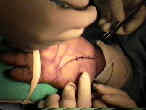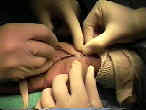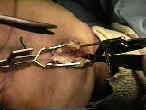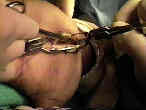- See: Anatomy of Carpal Tunnel
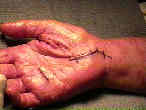
- Anesthesia:
- Bier Block:
- proponents note that regional anesthesia allows a less rushed operation along w/ a synovectomy, if needed;
- median nerve block at elbow;
- w/ elbow extended brachial artery is palpated in upper part of cubital fossa, medial to biceps tendon;
- median nerve lies medial to artery, & injection is made level w/ line drawn between medial & lateral epicondyles;
- injection into vessels (superficial veins), must be avoided;
- median nerve is deep to the deep fascia;
- a special blunt tipped needle is required to avoid nerve injury;
- carpal tunnel block;
- local block: (see: lidocaine / bupivacaine);
- proponents note that this technique allows the patient to move the thumb after the operation, demonstrating activity of the motor branch;
- disadvantage is that tourniquet is poorly tolerated, and subcutaneous tissues become boggy (interfering with the dissection);
- reference:
- Surgical release of the median nerve under local anaesthesia for carpal tunnel syndrome.
- Tourniquet:
- Carpal tunnel release without a tourniquet.
- Haemostasis during carpal tunnel release under local anaesthesia: a controlled comparison of a tourniquet and adrenaline infiltration.
- Upper extremity tourniquet effects in carpal tunnel release.
- Incision:
- equipement checklist
- Transverse Carpal Ligament Incision
- Release of Antebrachial Fascia:
- note that the most common cause of failure of surgery is incomplete division of the proximal part of the ligament;
- to avoid injury to the palmar cutaneous nerve, incise the fascia in line with the long finger (release for a distance of 3 cm);
- hazards:
- above wrist, it is important to distinguish median nerve from flexor tendons;
- nerve at this level may resemble a tendon because it is flattened rather than round, but in living body nerve is normally whiter and has fine vessels on its surface;
- tendon of FCR is on radial side of nerve and tendon of palmaris longus, & course superficial to flexor retinaculum to reach the skin;
- it thus is not involved in carpal compression;
- Isolation of Nerve:
- one should investigate whether motor branch is compressed by a fascial ring that surrounds nerve as it enters the thumb muscles;
- in the report by Arons JA, et al, 227 successive cases of carpal tunnel syndrome confirmed by abnormal EMG studies were reviewed;
- duration of preoperative symptoms ranged from 2 years to more than 10 years;
- all underwent open carpal tunnel release by a single surgeon over a 3-year period;
- 32 hands (14% of all cases) in 29 patients demonstrated an hourglass deformity at the time of surgery;
- electrodiagnostic tests revealed no evidence of any other type of peripheral neuropathy in any patient;
- length of the follow-up period averaged 11 months (range, 3-35 months);
- 28 of the 32 hands (88%) with hourglass deformities demonstrated subjective clinical improvement or complete resolution of symptoms;
- references:
- Interfascicular neurolysis in the severe carpal tunnel syndrome. A prospective, randomized, double-blind, controlled study.
- Results of internal neurolysis of the median nerve for severe carpal-tunnel syndrome.
- Results of treatment of severe carpal-tunnel syndrome without internal neurolysis of the median nerve.
- Internal neurolysis fails to improve the results of primary carpal tunnel decompression.
- Results of treatment of carpal tunnel syndrome with associated hourglass deformity of the median nerve.
- The thenar motor branch during carpal tunnel decompression: “the expert opinion”
- Variations in the course of the thenar motor branch of the median nerve and their relationship to the hypertrophic muscle overlying the transverse carpal ligament.
- Variations in the anatomy of the third common digital nerve and landmarks to avoid injury to the third common digital nerve with carpal tunnel release.
- Anatomical relationships among the median nerve thenar branch, superficial palmar arch, and transverse carpal ligament
- Anatomic investigations of nerves at the wrist: I. Orientation of the motor fascicle of the median nerve in the carpal tunnel.
- Anatomic relations between the median nerve and flexor tendons in the carpal tunnel: MR evaluation in normal volunteers.
- Variations of the median nerve in the carpal canal.
- Additional Procedures:
- tendon transfers for low median palsy:
- camitz procedure
- Camitz Tendon Transfer Using Flexor Retinaculum as a Pulley in Advanced Carpal Tunnel Syndrome
- synovectomy:
- may be required in some cases (especially rheumatoid arthritis);
- in idiopathic carpal tunnel syndrome the synovial histology will reveal benign fibrous tissue without inflammation;
- in the report by Shum C, et al (2002), the authors conducted a prospective, randomized study to evaluate the effect of flexor
tenosynovectomy as an adjunct to open carpal tunnel release;
- 88 wrists in 97 patients with idiopathic carpal tunnel syndrome were randomized to open carpal tunnel release with or
without flexor tenosynovectomy;
- study group included 15 men and 72 women with a mean age of 58 years;
- half of the wrists were then treated with a flexor tenosynovectomy through the operative incision, and the tenosynovium
was graded histologically;
- after the operation, both groups improved significantly with respect to symptom severity and functional status (paired t
test), with no significant difference between the groups (unpaired t test);
- no significant correlation was found between the gross appearance of the tenosynovium and the preoperative or
postoperative symptoms and functional status, between the histologic appearance of the tenosynovium and the
preop or postop symptoms and functional status, or between the gross and the histologic findings.
- the authors suggest that routine flexor tenosynovectomy offers no benefit compared with sectioning of the transverse carpal ligament alone for the treatment of idiopathic carpal tunnel syndrome.
- references:
- An analysis of the flexor synovium in idiopathic carpal tunnel syndrome: report of 625 cases.
- Synovial histology in carpal tunnel syndrome.
- The Role of Flexor Tenosynovectomy in the Operative Treatment of Carpal Tunnel Syndrome
- Wound Closure:
- in young patients or patients who have had flexor tendon repairs consider Z plasty of TCL (along w/ release of Guyon's canal) to
prevent bowstringing of tendons during flexor tendon repair;
- reference:
- The transverse carpal ligament. An important component of the digital flexor pulley system.
- Post Operative Care and Complications
Flexor carpi radialis approach for carpal tunnel release.
Distribution of nerve fibers in the standard incision for carpal tunnel decompression.
Anatomy of the flexor retinaculum.
[Double incision for operation of carpal tunnel syndrome--14 years experience.]
Recurrent carpal tunnel syndrome, epineural fibrous fixation, and traction neuropathy.
Local symptoms after open carpal tunnel release. A randomized prospective trial of two incisions.
Double incision open technique for carpal tunnel release: an alternative to endoscopic release.
Carpal tunnel release. A prospective, randomised study of endoscopic versus limited-open methods.
The Palmar Fat Pad Is a Reliable Intraoperative Landmark During Carpal Tunnel Release



